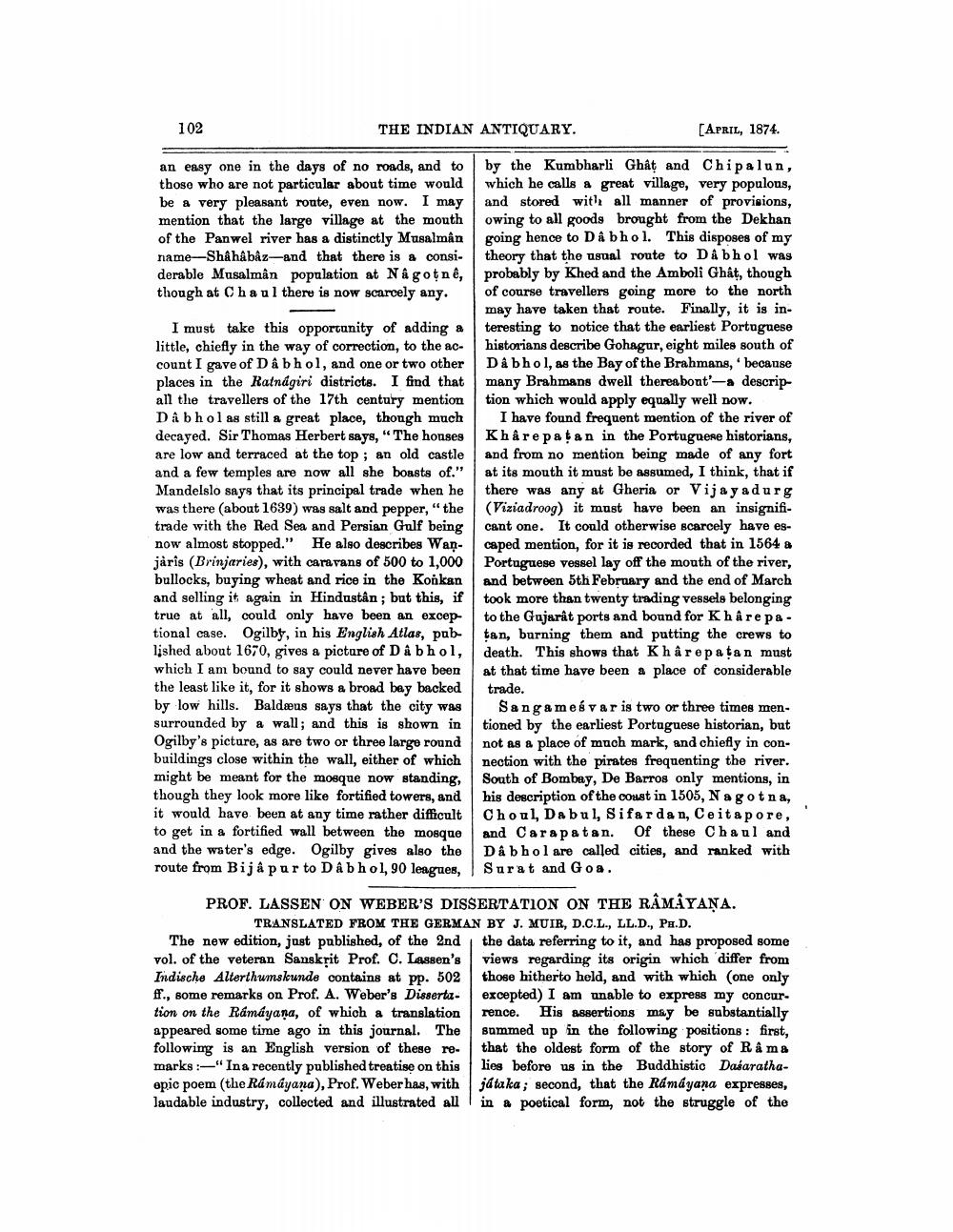________________
102
THE INDIAN ANTIQUARY.
[APRIL, 1874.
an easy one in the days of no roads, and to by the Kumbharli Ghat and Chipalun, those who are not particular about time would which he calls a great village, very populous, be a very pleasant route, even now. I may and stored with all manner of provisions, mention that the large village at the mouth owing to all goods brought from the Dekhan of the Panwel river has a distinctly Musalman going hence to Dá bhol. This disposes of my name--Shâ hâbâz-and that there is & consi- theory that the usual route to D Abhol was derable Musalman population at Någotnê, probably by Khed and the Amboli Ghat, though though at Chaul there is now scarcely any. of course travellers going more to the north
may have taken that route. Finally, it is inI must take this opportunity of adding a teresting to notice that the earliest Portuguese little, chiefly in the way of correction, to the ac- historians describe Gohagur, eight miles south of count I gave of Dabhol, and one or two other Dabhol, as the Bay of the Brahmans, because places in the Ratnagiri districts. I find that many Brahmans dwell thereabout'-a descripall the travellers of the 17th century mention tion which would apply equally well now. D A bhol as still a great place, though much I have found frequent mention of the river of decayed. Sir Thomas Herbert says, "The honses Khårepatan in the Portuguese historians, are low and terraced at the top; an old castle and from no mention being made of any fort and a few temples are now all she boasts of." at its mouth it must be assumed, I think, that if Mandelslo says that its principal trade when he there was any at Gheria or Vijay adurg was there (about 1639) was salt and pepper, “the (Viciadroog) it must have been an insignifitrade with the Red Sea and Persian Gulf being cant one. It could otherwise scarcely have esnow almost stopped." He also describes Wan- caped mention, for it is recorded that in 1564 a járis (Brinjaries), with caravans of 500 to 1,000 Portuguese vessel lay off the mouth of the river, bullocks, buying wheat and rice in the Konkan and between 5th February and the end of March and selling it again in Hindustân; but this, if took more than twenty trading vessels belonging true at all, could only have been an excep- to the Gujarat ports and bound for Khårepa. tional case. Ogilby, in his English Atlas, pub- tan, burning them and putting the crews to lished about 1670, gives a picture of Dá bhol, death. This shows that Khârepatan must which I am bound to say could never have been at that time have been a place of considerable the least like it, for it shows a broad bay backed trade. by low hills. Baldæus says that the city was Sangames var is two or three times mensurrounded by a wall; and this is shown intioned by the earliest Portuguese historian, but Ogilby's picture, as are two or three large round not as a place of much mark, and chiefly in conbuildings close within the wall, either of which nection with the pirates frequenting the river. might be meant for the mosque now standing, South of Bombay, De Barros only mentions, in though they look more like fortified towers, and his description of the coust in 1505, N agotna, it would have been at any time rather difficult Chool, Dabul, Sifardan, Ceit apore, to get in a fortified wall between the mosque and Carapatan. Of these Chaul and and the water's edge. Ogilby gives also the Dabhol are called cities, and ranked with route from Bijapur to Dâbhol, 90 leagues, Surat and Goa.
PROF. LASSEN ON WEBER'S DISSERTATION ON THE RAMAYANA.
TRANSLATED FROM THE GERMAN BY J. MUIR, D.C.L., LL.D., PH.D. The new edition, just published, of the 2nd the data referring to it, and has proposed some vol. of the veteran Sanskrit Prof. C. Lassen's views regarding its origin which differ from Indische Alterthumskunde contains at pp. 502 those hitherto held, and with which one only ff., some remarks on Prof. A. Weber's Disserta- excepted) I am unable to express my concur. tion on the Ramayana, of which a translation rence. His assertions may be substantially appeared some time ago in this journal. The summed up in the following positions : first, following is an English version of these re- that the oldest form of the story of Rama marks :-"Ina recently published treatise on this lies before us in the Buddhistic Dasarathaepic poem (the Rámáyana), Prof. Weber has, with ja taka; second, that the Ramayana expresses, laudable industry, collected and illustrated all in a poetical form, not the struggle of the




